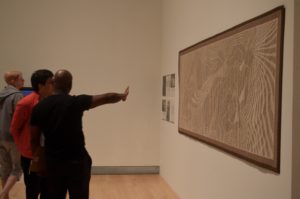Uncertainty is a fact of life in medicine. Navigating it may be the most important and complex task clinicians encounter in their daily work.
My teaching practice has allowed me the privilege of working with great clinicians and clinical teachers over the better part of two decades. Through this work I have noticed that masterful clinicians respond to uncertainty profoundly differently than is the workplace norm.
In fact, they don’t react to it at all.
Rather than treating uncertainty as the enemy, they leverage it as a space for discovery and connection. They look through it, like a window. They look with it, like a friend.
In short, they look with uncertainty.

Through observing great clinicians in action, interviewing and co-teaching with them, as well as reviewing the literature on human development as it relates to medical practice (a lot of it in clinical reasoning), I’ve come to identify key ways in which masterful clinicians approach, respond to, and communicate about uncertainty. I believe that these practices are at the heart of what it takes to deliver safe, quality care that is satisfying to clinician and patient alike.
Many of these practices align with known practices of arts engagement–in and of itself an uncertain experience. I’ve tracked those, too, and come to see how they all boil down to trust, attention, and language.
The framework of practices resulting from this research has shaped the conceptual spine of a new body of ArtsPractica workshops: Looking with UncertaintySM. Learners will engage with uncertainty in arts experiences as a context to develop familiarity, tools, and success for navigating it.
I’m excited to announce that I’ll be teaching a full-semester version of Looking with Uncertainty at Brandeis University this spring, in the Health: Science and Social Policy Program and at the Rose Art Museum, Brandeis’s campus museum.
I’ll also be speaking about this research in Grand Rounds and public lecture formats. I’m excited for the Looking with Uncertainty work to enter this next phase and will blog about the learnings as we go.
Looking with Uncertainty is deeply informed by the voices of patient safety experts who share a concern for the way in which uncertainty is addressed, managed, and discussed in healthcare. A great example is Ten Principles for More Conservative, Care-Full Diagnosis authored by Gordon Schiff and (highly cross-disciplinary) colleagues. Importantly, Principle #2 advocates for a the development of a “New Science of Uncertainty.”
Looking with Uncertainty also joins a significantly growing literature from the realm of health humanities suggesting that interactive experiences with the arts and humanities may offer a paradigm for medical learners to learn to tolerate, manage, and embrace uncertainty. To name just a few:
- Dr. Rita Charon ‘s deliverance of the National Endowment for the Arts ‘s annual Jefferson Lecture in the Humanities.
- Dr. Jay Baruch on “Why we need more not-knowing in medicine“
- Gowda et. al, Art as Sanctuary: A Four-Year Mixed-Methods Evaluation of a Visual Arts Course Addressing Uncertainty through Reflection
- Danielle Ofri, Medical Humanities: The Rx For Uncertainty?
- It is exciting to see these programs and studies take hold after many years of talking within the field. It’s also extremely telling that the physicians invested in the delivery of quality care to the extent that they talk, write, and teach about it are both highly concerned with uncertainty and also have a life, a big life, in the arts, separate from and directly feeding their practice with patients.
There’s lots of need here, and so much to explore.
Stay tuned for more on Looking with Uncertainty, and feel free to follow along on twitter as well as Looking with Uncertainty’s twinkly new instagram feed.
Thoughts, feelings, quesitons, suggestions, drop a line!

